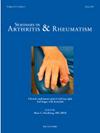Genome-wide association study for loci associated with positive antinuclear antibodies
IF 4.4
2区 医学
Q1 RHEUMATOLOGY
引用次数: 0
Abstract
Background
The genetic basis, heritability, and genetic differences by patterns and titers of antinuclear antibodies (ANA) are still poorly understood.
Methods
Within the Mass General Brigham Biobank, containing electronic health records (EHR) and genotyping for >65,000 consented patients, we identified individuals with HEp-2 immunofluorescence ANA results (1989–2022) and genetically predicted European ancestry. We performed genome-wide associated studies for ANA+ ≥ 1:40, ≥ 1:80, all and in speckled and homogeneous ANA patterns, for those only +1:40, and then excluding those with ≥1 of 9 ANA-associated autoimmune diagnoses, each compared to those ANA- and adjusted for age, sex, and 4 genetic principal components. The lability method estimated ANA+ heritability. We investigated HLA alleles using SNP2HLA imputation.
Results
7035 subjects were ANA+ at ≥1:40, 4279 at ≥1:80 and 5840 were ANA -. Associations were similar but stronger for ANA ≥1:80 than ≥1:40. Associations were stronger for speckled and homogeneous ANA patterns separately (each vs. all ANA-) and attenuated after excluding those with ≥1 autoimmune disease diagnosis. At both titers, HLA-DQB1:0201 had the strongest association, OR 1.3 (95 % CI 1.2–1.5, p 9.1 × 10–14 for ANA ≥1:80); HLA-B:08, HLA-DRB1:03, and HLA:C:0701 alleles also showed significant associations. The strongest non-HLA association was rs34748780 (chromosome 7) near IRF5/TNPO3, OR 1.2 (95 % CI 1.1–1.4, p 1.6 × 10–8 for ANA ≥1:80). ANA+ ≥1:40 heritability was 12 % (SE 0.03), p 1.0 × 10–8 and ≥1:80 was 19 % (SE 0.03), p 1.9 × 10–12.
Conclusion
HLA-DQB1:0201, HLA-DRB1:03, HLA-B, and HLA-C were strong genetic factors for ANA+ in these European ancestry individuals.

抗核抗体阳性相关位点的全基因组关联研究
关于抗核抗体(ANA)的遗传基础、遗传力以及模式和滴度的遗传差异仍然知之甚少。方法:在麻省总医院布里格姆生物银行(Mass General Brigham Biobank)中,包含65,000名同意患者的电子健康记录(EHR)和基因分型,我们确定了HEp-2免疫荧光ANA结果(1989-2022)和遗传预测欧洲血统的个体。我们对ANA+≥1:40、≥1:80、所有斑点型和同质型ANA进行了全基因组相关研究,仅对+1:40的ANA进行了研究,然后排除了9种ANA相关自身免疫诊断中≥1种的患者,每一种都与ANA相比较,并根据年龄、性别和4种遗传主成分进行了调整。不稳定性法估计ANA+遗传力。我们使用SNP2HLA代入方法研究HLA等位基因。结果≥1:40 ANA阳性7035例,≥1:80 ANA阳性4279例,ANA阴性5840例。ANA≥1:80与≥1:40的相关性相似,但更强。斑点型和同质型ANA模式的相关性更强(每一种与所有ANA-),在排除≥1种自身免疫性疾病诊断后,相关性减弱。在两个滴度下,HLA-DQB1:0201的相关性最强,OR为1.3 (95% CI 1.2-1.5, p 9.1 × 10-14, ANA≥1:80);HLA- b:08、HLA- drb1:03和HLA:C:0701等位基因也有显著相关性。非hla相关性最强的是rs34748780(第7染色体)靠近IRF5/TNPO3, OR为1.2 (95% CI 1.1-1.4, p 1.6 × 10-8, ANA≥1:80)。ANA+≥1:40遗传率为12% (SE 0.03), p 1.0 × 10-8;≥1:80遗传率为19% (SE 0.03), p 1.9 × 10-12。结论hla - dqb1:0201、HLA-DRB1:03、HLA-B和HLA-C是这些欧洲血统个体ANA+的强遗传因素。
本文章由计算机程序翻译,如有差异,请以英文原文为准。
求助全文
约1分钟内获得全文
求助全文
来源期刊
CiteScore
9.20
自引率
4.00%
发文量
176
审稿时长
46 days
期刊介绍:
Seminars in Arthritis and Rheumatism provides access to the highest-quality clinical, therapeutic and translational research about arthritis, rheumatology and musculoskeletal disorders that affect the joints and connective tissue. Each bimonthly issue includes articles giving you the latest diagnostic criteria, consensus statements, systematic reviews and meta-analyses as well as clinical and translational research studies. Read this journal for the latest groundbreaking research and to gain insights from scientists and clinicians on the management and treatment of musculoskeletal and autoimmune rheumatologic diseases. The journal is of interest to rheumatologists, orthopedic surgeons, internal medicine physicians, immunologists and specialists in bone and mineral metabolism.

 求助内容:
求助内容: 应助结果提醒方式:
应助结果提醒方式:


